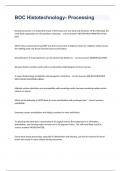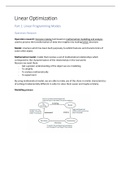Managing Internationalization
Inhoud
Chapter 2: Initiation of internationalization (session 1) ......................................................................................... 3
2.1 Introduction .................................................................................................................................................. 3
2.2 Internationalization motives ......................................................................................................................... 3
2.3 Triggers of export initiation (change agents) ................................................................................................ 7
2.4 Internationalization barriers/risks .............................................................................................................. 10
2.7 Case study: TOMS ....................................................................................................................................... 12
2.8 Case study: Elvis Presley Enterprises .......................................................................................................... 12
Extra questions ................................................................................................................................................. 12
Chapter 3: Internationalization theories (session 2) ............................................................................................. 13
3.1 Introduction ................................................................................................................................................ 13
3.2 The Uppsala internationalization model..................................................................................................... 14
3.3 The transaction cost analysis (TCA) model ................................................................................................. 15
3.4 The network model ..................................................................................................................................... 17
3.5 Born globals ................................................................................................................................................ 17
3.6 Summary ..................................................................................................................................................... 18
Extra questions ................................................................................................................................................. 19
Chapter 6: The political and economic environment (session 3) .......................................................................... 20
6.1 Introduction ................................................................................................................................................ 20
6.2 The political/legal environment .................................................................................................................. 20
6.3 The economic environment ........................................................................................................................ 25
6.4 The European Economic and Monetary Union and the euro ..................................................................... 27
6.5 BRIC - the slowing growth is hitting the merging countries ....................................................................... 28
6.6 ‘Bottom of pyramid’ (BOP) as a market opportunity .................................................................................. 28
Chapter 7: The sociocultural environment (session 4) ......................................................................................... 29
7.1 Introduction ................................................................................................................................................ 29
7.2 Layers of culture ......................................................................................................................................... 30
7.3 High- and low-context cultures................................................................................................................... 30
7.4 Elements/components of culture ............................................................................................................... 31
7.5 Hofstede’s model (the 4+1 dimensions model) versus the GLOBE model ................................................. 32
7.6 Managing cultural differences .................................................................................................................... 35
Extra questions ................................................................................................................................................. 35
Chapter 8: The international market selection process (session 5) ...................................................................... 36
8.1 Introduction ................................................................................................................................................ 36
8.2 International Market Selection: SMEs versus LSEs ..................................................................................... 36
, 8.3 Building a model for international market selection .................................................................................. 37
8.4 Market expansion strategies ...................................................................................................................... 39
Extra questions ................................................................................................................................................. 39
Chapter 9: Some approaches to the choice of entry mode (session 6) ................................................................ 41
9.1 Introduction ................................................................................................................................................ 41
9.2 The transaction cost approach ................................................................................................................... 41
9.3 Factors influencing the choice of entry mode ............................................................................................ 41
9.4 Summary ..................................................................................................................................................... 44
Extra question ................................................................................................................................................... 44
Chapter 10: Export modes (session 7) .................................................................................................................. 46
10.1 Introduction .............................................................................................................................................. 46
10.2 Indirect export modes .............................................................................................................................. 46
10.3 Direct export modes ................................................................................................................................. 48
10.4 Cooperative export modes/export marketing groups .............................................................................. 50
10.5 Summary ................................................................................................................................................... 50
Extra questions ................................................................................................................................................. 50
Chapter 11: Intermediate Entry Modes (session 8) .............................................................................................. 52
11.1 Introduction .............................................................................................................................................. 52
11.2 Contractual manufacturing ....................................................................................................................... 52
11.3 Licensing ................................................................................................................................................... 52
11.4 Franchising ................................................................................................................................................ 52
11.5 Joint ventures/strategic alliances ............................................................................................................. 53
11.6 Other intermediate entry modes .............................................................................................................. 55
Extra questions ................................................................................................................................................. 55
Chapter 12: Hierarchical Modes (session 9).......................................................................................................... 56
12.1 Introduction .............................................................................................................................................. 56
12.2 Domestic-based sales representatives ..................................................................................................... 56
12.3 Resident sales representatives/foreign sales branch/foreign sales subsidiary ........................................ 56
12.4 Sales and production subsidiary ............................................................................................................... 57
12.5 Region centers (regional headquarter (HQ)) ............................................................................................ 58
12.6 Transnational organization ....................................................................................................................... 58
12.7 Establishing wholly owned subsidiaries - acquisition or greenfield ......................................................... 58
12.8 Location/relocation of HQ ........................................................................................................................ 59
12.9 Foreign divestment: withdrawing from a foreign market ........................................................................ 59
12.10 Summary ................................................................................................................................................. 60
Extra questions: ................................................................................................................................................ 60
2
,Chapter 2: Initiation of internationalization (session 1)
Learning objectives:
− Discuss the reason (motives) why firms go international
− Explain the difference between proactive and reactive motives
− Analyze the triggers of export initiation
▪ Explain the difference between internal and external triggers of export initiation
− Describe different factors hindering export initiation
− Discuss the critical barriers in the process of exporting.
2.1 Introduction
Internationalization → expanding R&D, production, selling and other business activities to
international markets.
− Large enterprises: internationalization = continuous fashion
− Small and medium-sized enterprises (SMEs): internationalization = discrete process
In pre-internationalization stages, SME managers use information to achieve enough knowledge to
initiate internationalization. This figure shows the stages in pre-internationalization.
2.2 Internationalization motives
Fundamental reason for exporting = making money. Usually, a mixture of factors/reasons results in
firms taking steps in a given direction. John H. Dunning distinguished four main motives.
− Market-seeking: finding new customers
− Efficiency-seeking: lowering costs associated with performing economic activities,
rationalization the already existing operations in various locations
− Resource-seeking: access resources that are not available at home or can be obtained at a
lower cost abroad
− Strategic asset-seeking: obtaining strategic assets not available at home 🡪 critical for long-
term strategy
3
, Internationalization motives are differentiated into proactive and reactive motives. The main driving
forces motivating internationalization are found within the firm, so they are based on the strengths
and weaknesses of the management.
2.2.1 Proactive motives
Proactive motives represent stimuli to attempt strategy change, based on the firm’s interest in
exploiting unique competences or market possibilities.
According to a study of Westhead, bigger firms are more likely to cite proactive stimuli/motives
Profit and growth goals
− Desire for short-term profit and growth at stage of initial interest in exporting
− Longer term → increasing profit results in selling more or buying cheaper
− Over time, feedback from past efforts influences attitude towards growth
− The stronger the firm’s motivation to grow, the greater will be the activities it generates
Managerial urge
− = managers’ commitment and motivation that reflect the desire and enthusiasm to drive
internationalization forward
− Managerial attitudes play critical role in determining exporting activities of the firm
− Cultural socialization of managers can encourage internationalization process
▪ E.g. managers born/living abroad are more internationally minded
Technology competence/unique product
− A firm can produce goods/services that are not widely available from international
competitors or have made technological advances in a specialized field
− Unique products provide a competitive advantage and success abroad, but the company has
to keep in mind that the success will not last forever
− However in general, the firm is more likely to have a bigger demand from foreign markets
Foreign market opportunities/market information
− Decision-makers in a firm first rather consider a limited number of opportunities in planning
foreign entry, since market entry is very costly and risky
▪ Maybe the opportunities have some similarity with the opportunities in the home
market → not worth it to expand to that market
4



